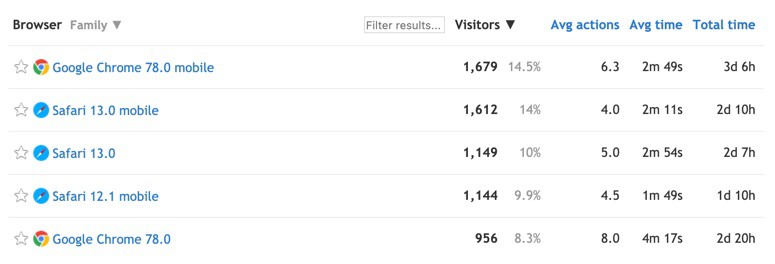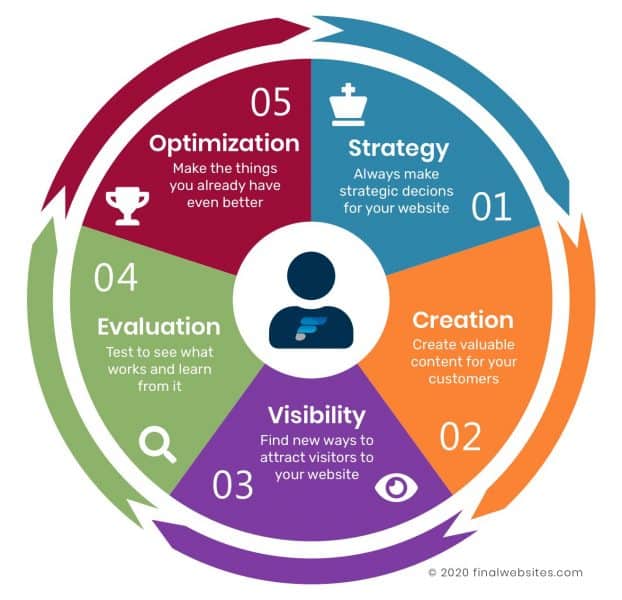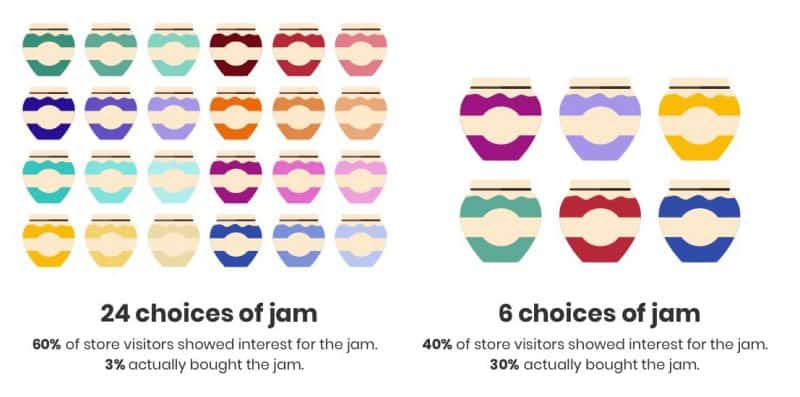Improve your website frequently by using the WOC
It happens all the time, a business owner invests in a new website and abandons his “shiny” property after a few weeks. A new website is not a printed leaflet and without any attention the owner will miss the necessary results. For a successful website, a site owner needs to work on his website continuously. Don’t know how? In this blog post I will show you how to use the WOC to improve your website.

But first…
Why your website is never finished
My website is live and is not yet finished? Actually, not quite. Your website is maybe ready to present to your customers, but this isn’t good enough. A really good website is a process and not an end product.
“Your website is never finished, because there is no such thing as a perfect website.”
To make it more understandable, below you will find 5 influences that make it necessary for you to improve your website frequently.
- Your products or services change. New products become available and old ones disappear. Or you change the way you communicate the product’s advantages. Or you got new testimonials from customers. All of these are reason enough to update your website.
- The competition grows. A new competitor enters the market or old competitors are improving. Which means you have to work harder to reach the same results.
- The environment changes. For example more old people are using the web now, and are not so skilled as millennials.
- Changes to law and regulation. As a website owner you have to take care about new laws and regulations. Remember about the impact of the GDPR?
- The web innovates. The web has evolved so much during the last 10 years. That’s why your website needs to change too. Don’t forget the mobile revolution. More and more people are using only their phone to visit your website.

Continue with your old website or start over?
Now you know that you should improve your website continuously. The big question is: should you continue with your current website or should you start a new one?
It depends, answer yourself the following questions and decide then if you need a new website or not:
- Is your website flexible enough for (bigger) changes? Are all desired functions available in your current setup?
- How does your website ranks in Google? While changing your website, you should always be careful with your current rankings in Google. If your website doesn’t have so much good rankings, changing your website carries less risks than a website with good results in Google.
- Is your current website modern and appealing? Perhaps it’s time for something new. Does it look like your website is from the previous century? It’s time for new website!
Is the conclusion that your website is good enough for the next 1-2 years, then it’s time for some systematic changes. Keep reading and I will show you what’s next.
Have you heard about the WOC?
Every website modification takes time and for most of us, time is very valuable. That’s why working on your own website might get a low priority. Besides lack of time it’s possible that you have no clue where to start.
For this kind of struggles we called the WOC into life. WOC stands for Website Optimization Circle. We came up with the WOC to help people, like you, to improve their website constantly and in a structured way.

The circle has 5 phases: Strategy, Creation, Visibility, Evaluation and Optimization. Work on these phases for better results and more success.
Important: the WOC is not a guide you have to follow from the beginning to the end all over again. You need to work on these phases which matters most for your website. Don’t skip any phases for good, because every phase is important for the success of your website!
I will explain the 5 different phases of the WOC in the next section of this article.
Strategy: Always make strategic decisions for your website
Whatever you like to change on your website, every decision must be based on some kind of strategy. This phase is not about creating a complete online strategy, but about strategy guided working.
At any moment you should know what you’re doing and why are you doing it. That means you don’t create content without a goal, no “call to action” without a reason and no modification is done without a proper argumentation.
Here you can see some examples of the things you can make strategic decisions about.
- Content marketing
- Email marketing
- Social media marketing
- SEO
- Advertising
- Customer journey
- Website user experience
- Personalized experiences
- Brand Message
- Tone of voice
- Recognition
- Trustworthiness
- USPs & UBRs
- Call to actions
3 tips for strategic decisions
For a quick start, we have 3 tips for your strategic working process :
- Start with a goal. It looks so obvious, but we do so many things without a clear objective. Don’t just start with blogging, social media or email marketing, but evaluate every step you like to accomplish and choose an objective that is achievable. For example, do you sell a product where people are not searching for? I’m sure the product has some related keywords people are using for a web search. Use these keywords as a subject for your new content.
- Check always what your competition is doing. If you like to be sure that your decisions are right, you need to know as much as possible about your target audience. Check the websites from your competition and you will be surprised how much you can learn about your customer from them. Visit also the websites from similar companies located in other countries. Don’t forget, if you like to be different from your competition, you need to know what they are actually doing.
- Start always simple. In the beginning, it’s not necessary that you have advanced strategic plans to get more website visitors or to improve the usability. Look out for common pitfalls and solve them first. For example detect pages without any “call to action”, content with missing search keywords and automatic emails which haven’t provided any results for a long time.
Do you like to know how to combine this phase with other phases? At the end of this blog post I will provide some examples. Don’t stop reading!
Creation: Create valuable content for your customers
Many business owners think that their website should be about the company: what kind of products are for sale, who is working there and what is the company’s mission. This is a misconception. Sure, your visitor likes to know who you’re, but this is only a tiny aspect of your website.
Your website and the information on your website should be about what the customer needs and should contain relevant and valuable information for the visitor. The visitors’ questions and issues should be the center point of any content on your website. At least if you like to be successful…
If you like to provide valuable content for your (potential) customer, you need to create blog posts, regular pages and other content types like social media posts, newsletters, e-books…
3 tips for creating valuable content
To make the most out of your content, we have some tips.
- Don’t be afraid to share your secrets. Most companies in the same field publish often the same content. If you like to be online successful, you need to create content that is better, complete and most informative. The goal is to share information that is not available on other websites.
- Create long lasting content. The best content is useful for a longer period of time. Don’t spend too much time on creating news items. Background information should also be updated from time to time, but it will not expire as fast as news.
- Re-use your content for other channels. The best concept for creating content is, that all pieces are connected with each other. Do you publish a blog post about a specific subject? Use the same information for your newsletter too. And share your best tips from that artikel in a series of social media posts.
Visibility: Find new ways to attract visitors to your website
Very often people think they need more and more followers. But what happens when you have 300k followers and no engagement? What happens when you have 1000 visitors a day, but no conversions and the bounce rate is sky high? Nothing happens…
So, the quality of your audience is as important as it’s quantity. As a business owner you should always work on the visibility of your website, not only to get new visitors, but also to increase the amount of returning visitors. This is possible in different ways.
For example by:
- Improving your search engine position(s)
- Advertising in search engines and on other websites
- Sending a newsletter frequently
- Working together with other websites / influencers
- Creating offline campagnes
Do you work enough on the visibility of your website? Otherwise your visitors won’t find you and your activities for the other 4 phases will be less effective.
3 tips to make your website more visible
The online success of your company depends on how visible your website is. These tips will help you to raise your visibility:
- Learn more about your target audience. Which search keywords are used by your potential customer, what are the channels to reach them, which companies / influencers do they follow? You need this kind of information to reach them in the future.
- Create acknowledgement. Use your visual identity for all your communications. People are exposed to a lot of messages every day. You need to be sure that your potential customers will recognize every message originating from you.
- Choose an approach that is honest and authentic. Most people will notice if your message is honest or not. Don’t fool your potential customers and be honest about your intentions. Find a balance between the promotion of your company and being helpful with valuable and good content.
Evaluation: Test to see what works
A big website with many visitors is a good website, right? Not at all. Because the visitor who can’t find the information he is looking, will leave your website early. Or even if your website has a lot of visitors, it might still not lead to the desired results, because your visitors never fill in a web form or buy a product.
Many people think A/B testing is the best way to analyze your website. But the problem is that you actually need many visitors or a lot of time to gather enough data. This means that for many website owners, A/B testing is not an option, yet. Of course there are other sources you can use, for example:
- Website statistics and other tools
- Reviews about your company or competitors
- Check other websites and learn from them.
3 tips to test what works
I you like to improve your website, it’s necessary to know what works. Use the following tips:
- Don’t trust visitor’s initial behavior alone. That a visitor has left your website, says nothing about the reason. A wild guess might help, but it’s better to change small things, one at a time, to find the reason that someone is leaving your website so soon.
- Measure all your conversion elements. Don’t forget to measure all kinds of conversions – Even if you’re not a webshop owner, measure conversions like the number of submitted contact forms, the number of subscriptions to your newsletter and important buttons on your website. Use measure points as goals in your analytics software.
- Don’t forget your website is made for the visitors. Your opinion about your website is actually not so important. More important is that your audience is able to find the necessary information and can navigate your website quickly. If you like to be more successful with your website, it’s important to ignore your own choices and provide what your visitors really need.
Optimization: make what you have, even better
At the time that you know what works and what not, it’s time to “translate” your research into website improvements. But, be aware of over-optimization. Many business owners think that optimizing more will bring more and better results. One common mistake is to place more and more conversion elements on the same web page.
More is not always better. In most case scenarios it’s better to think about a new and better conversion element, than adding extra elements. Too much conversion elements might be the reason that a visitor becomes irritated and will leave your website.

Your goal is to improve your website strategically (see how the different phases are connected). Here is a list of things you can optimize to get better results:
- Call to actions
- Content
- Technic /website speed
- User experience
- Sales Funnel
- Brand experience
- Mobile experience
- Accessibility
3 tips to improve what you already have
How to improve the different parts of your website, is different for each part. I have 3 tips for you:
- Don’t change too much at the same time. Take smaller steps while optimizing your website. If you change to much at the same time and the modifications doesn’t provide the accepted result, you have no idea which one is the problem. It’s also possible that one of the improvements obstruct others.
- Start optimizing your website for mobile. Many business owners forget that more people using their cell phones to visit the web. Any element should look great on all devices. Therefore, create your design or layout for mobile first, because creating websites for a big screen is more easier.
- Ask a website expert for a review. Do you have no idea where to start? Ask a specialized company for a site review. Search Google and I’m sure you will find some sites offering a free site check.
This is how you use the WOC
Use the 5 phases of the website optimization circle independently or in combination to have more success with your website. Now that you know what the 5 different phases are, I can tell you how to use them.
The WOC will help you while improving your website continuously. The 5 phases work all as starting points and solutions:
- You like to fulfill a specific goal, for example to collect email addresses from potential customers (strategy phase) and you came up with a free email course (creation phase).
- You’ve created a blog post (creation phase), but the article doesn’t show up in Google. Next you decide to write a similar guest blog post with a link to your own blog post (visibility phase).
- You send frequently a newsletter (visibility phase), but you have no idea which subjects deliver the best results. You decide to analyse which subjects provide the most clicks (evaluation phase).
- Your website’s page has a top 3 result for a popular search keyword, but most people don’t click on that result. You change the page (SEO) title and meta description to get more clicks (optimization phase).
- You’ve optimized a couple of blog posts for SEO (optimization phase) and these pages are getting more and more clicks via Google. Next you develop some new call to actions to get more interactions (strategy phase).
There are much more possibilities. After you have used the WOC for a while, ideas on how to improve your website will come up much easier.
A last reminder…
Don’t forget! Every phase is crucial for your online success. Don’t focus on only one or some phases. Make sure that every improvement on your website provides more (happy) customers, less visitors abandoning your website and more conversions. The WOC will help you to reach your goals!
Do you already use the WOC to improve your website? Share your experience below as a comment or on Twitter. I really like to hear how you use the tool.
Published in: Internet Marketing · Search Engine Optimization
